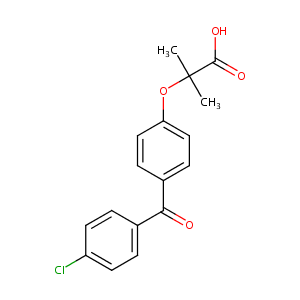Details of the Drug
General Information of Drug (ID: DMGO2MC)
| Drug Name |
FENOFIBRIC ACID
|
||||||||||||||||||||||
|---|---|---|---|---|---|---|---|---|---|---|---|---|---|---|---|---|---|---|---|---|---|---|---|
| Synonyms |
Fenofibric acid; 42017-89-0; Procetofenic acid; 2-(4-(4-Chlorobenzoyl)phenoxy)-2-methylpropanoic acid; alpha 1081; NSC 281318; LF 178 acid; UNII-BGF9MN2HU1; 2-[4-(4-chlorobenzoyl)phenoxy]-2-methylpropanoic acid; LF 153; FNF Acid; C17H15ClO4; Trilipix; CCRIS 7302; EINECS 255-626-9; BGF9MN2HU1; CHEMBL981; BRN 2058973; CHEBI:83469; 2-[4-(4-Chlorobenzoyl)phenoxy]-2-methylpropionic Acid; Propanoic acid, 2-(4-(4-chlorobenzoyl)phenoxy)-2-methyl-; AK117112; 2-{4-[(4-chlorophenyl)carbonyl]phenoxy}-2-methylpropanoic acid; W-106287
|
||||||||||||||||||||||
| Indication |
|
||||||||||||||||||||||
| Drug Type |
Small molecular drug
|
||||||||||||||||||||||
| Structure |
 |
||||||||||||||||||||||
| 3D MOL | 2D MOL | ||||||||||||||||||||||
| #Ro5 Violations (Lipinski): 0 | Molecular Weight (mw) | 318.7 | |||||||||||||||||||||
| Logarithm of the Partition Coefficient (xlogp) | 3.9 | ||||||||||||||||||||||
| Rotatable Bond Count (rotbonds) | 5 | ||||||||||||||||||||||
| Hydrogen Bond Donor Count (hbonddonor) | 1 | ||||||||||||||||||||||
| Hydrogen Bond Acceptor Count (hbondacc) | 4 | ||||||||||||||||||||||
| ADMET Property |
|
||||||||||||||||||||||
| Chemical Identifiers |
|
||||||||||||||||||||||
| Cross-matching ID | |||||||||||||||||||||||
Molecular Interaction Atlas of This Drug
 Drug Therapeutic Target (DTT) |
|
||||||||||||||||||||||||||||||||||||||||||||||
|---|---|---|---|---|---|---|---|---|---|---|---|---|---|---|---|---|---|---|---|---|---|---|---|---|---|---|---|---|---|---|---|---|---|---|---|---|---|---|---|---|---|---|---|---|---|---|---|
 Drug Transporter (DTP) |
|
||||||||||||||||||||||||||||||||||||||||||||||
 Drug-Metabolizing Enzyme (DME) |
|
||||||||||||||||||||||||||||||||||||||||||||||
| Molecular Interaction Atlas (MIA) | |||||||||||||||||||||||||||||||||||||||||||||||
Drug-Drug Interaction (DDI) Information of This Drug
|
Coadministration of a Drug Treating the Disease Different from FENOFIBRIC ACID (Comorbidity)
|
|||||||||||||||||||||||||||||||||||
Drug Inactive Ingredient(s) (DIG) and Formulation(s) of This Drug
References
| 1 | URL: http://www.guidetopharmacology.org Nucleic Acids Res. 2015 Oct 12. pii: gkv1037. The IUPHAR/BPS Guide to PHARMACOLOGY in 2016: towards curated quantitative interactions between 1300 protein targets and 6000 ligands. (Ligand id: 2662). | ||||
|---|---|---|---|---|---|
| 2 | Vlase L, Popa A, Muntean D, Leucuta SE: Pharmacokinetics and comparative bioavailability of two fenofibrate capsule formulations in healthy volunteers. Arzneimittelforschung. 2010;60(9):560-3. doi: 10.1055/s-0031-1296325. | ||||
| 3 | Characterization of the drug binding specificity of rat liver fatty acid binding protein. J Med Chem. 2008 Jul 10;51(13):3755-64. | ||||
| 4 | Fenofibric acid, an active form of fenofibrate, increases apolipoprotein A-I-mediated high-density lipoprotein biogenesis by enhancing transcription of ATP-binding cassette transporter A1 gene in a liver X receptor-dependent manner. Arterioscler Thromb Vasc Biol. 2005 Jun;25(6):1193-7. | ||||
| 5 | In vitro metabolism of fenofibric acid by carbonyl reducing enzymes. Chem Biol Interact. 2016 Oct 25;258:153-8. | ||||
| 6 | Cerner Multum, Inc. "Australian Product Information.". | ||||
| 7 | Al-Nawakil C, Willems L, Mauprivez C, et.al "Successful treatment of l-asparaginase-induced severe acute hepatotoxicity using mitochondrial cofactors." Leuk Lymphoma 55 (2014): 1670-4. [PMID: 24090500] | ||||
